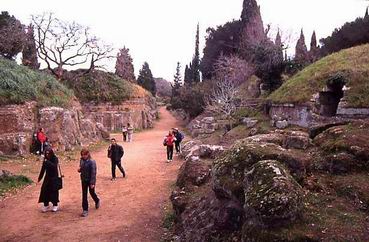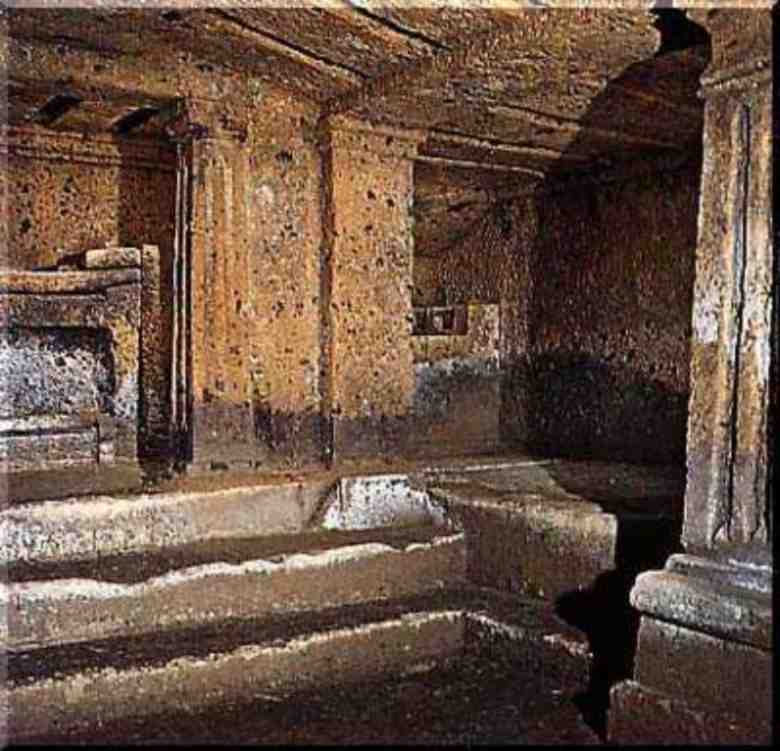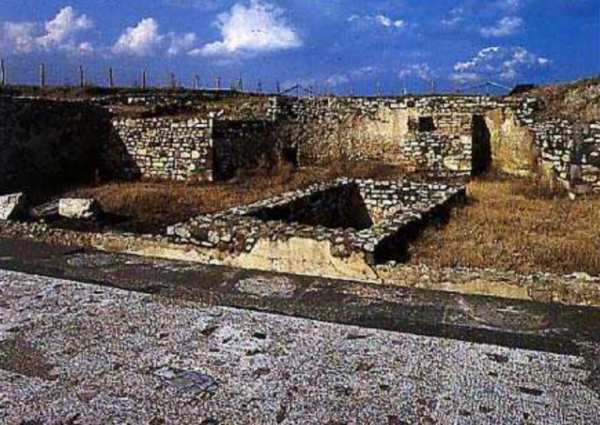|
|
Страници по тази тема: 1 | 2 | >> (покажи всички)
|
Тема
|
 Re: razni etruski krasoti Re: razni etruski krasoti [re: etruski-prodyljenie]
[re: etruski-prodyljenie]
|
|
| Автор | etruski-prodyljenie2 (Нерегистриран) |
| Публикувано | 26.03.05 00:17 |
|
|





PRILAGAM I TEKSTA,da ne bi nqkoj otnovo da si pomisli,4e ne e etrusko
"Les Étrusques ne ressemblaient à aucun autre peuple ni par la langue ni par le mode de vie et les moeurs "
(Denis d'Halicarnasse, Ier s. av. J.C.)
Les Étrusques étaient un peuple vivant entre le VIIème et le IIème siècles av. J.C. dans une vaste zone de l'Italie centrale. Ils ont joué un rôle important dans le développement de la culture, de l'écriture, de l'art et de l'artisanat tout au long des premiers siècles qui ont succédé à la préhistoire du vieux continent. Dans le territoire de la commune de Santa Marinella il y a de nombreux endroits où l'on a découvert des témoignages archéologiques d'importance fondamentale: vous ne manquerez certainement pas de vous amuser en vous laissant guider par nous dans le Musée Virtuel qui vous permettra de remonter le cours de l'histoire, de vous familiariser avec les us et coutumes d'un peuple qui a marqué les origines de notre ère. Pour commencer, choisissez l'un des sujets proposés.
...........
Le Travail des Métaux
Au VIIème s. av. J.C., dans le territoire de l'actuelle Toscane autour des Colline Metallifere , riches de cuivre, fer, plomb et argent, apparurent les ateliers du premier exemple d'industrie lourde de la péninsule italique . Ce fut justement sur des bases de ce genre que s'amorça la croissance économique de l'Étrurie et de ses richesses subséquentes. D'anciennes mines ont été repérées aux alentours de Tolfa, d'Allumiere, dans l'île d'Elbe, et dans la zone de Campiglia Marittima, près de Populonia. Le niveau technique de l'époque ne permettait que l'extraction du minerai des veines supérieures, mais malgré cela l'industrie extractive étrusque travaillait à une échelle extraordinaire, ainsi que le prouvent les restes de hauts fourneaux qu'on retrouve un peu partout.
Les Étrusques étaient considérés universellement comme de bons forgerons et on a retrouvé des restes d'installations de travail des métaux dans de nombreuses régions, où l'on utilisait des fours de fusion. Ceux-ci avaient une forme en tronc de cône d'environ un mètre et demi de diamètre. Ils étaient revêtus à l'intérieur de briques réfractaires et répartis en deux chambres séparées par une dalle horizontale trouée; dans la supérieure on plaçait le matériau à faire fondre et au-dessous l'on allumait le feu. Même la disposition des hauts fourneaux permet dapprécier le grand génie des Étrusques: ils étaient construits, en effet, dans les flancs de la montagne proche de la mine, où les vents ascendants et descendants tenaient lieu de soufflets naturels.
Les Étrusques excellaient aussi dans les phases suivantes du travail des métaux, qui les qualifiaient à un niveau de très haut artisanat, voire même artistique: l'orfèvrerie et le travail du bronze.
[image][http://www.comune.santamarinella.rm.it/museo/immagini/foto/reperti/r066.jpg/image]
.......
4AST OT PANTEONA NA ETRUSKITE:
[image]http://www.comune.santamarinella.rm.it/museo/immagini/foto/reperti/r041./image]
| |
|
|
|
[image]http://www.comune.santamarinella.rm.it/museo/immagini/foto/repe
| |
|
|
|
Popluna
VELSINIES
Clusium was one of the cities of the ancient Etruscan dodecapolis, sometimes called Camars or Clevsins. The site of the ancient city is now occupied by modern Chiusi, but on many places, tombs can be seen. This statue shows a deity that was called Mater Matuta ("mother Fertility") by the Romans. Today, it is at the Museo archeologico nazionale, Florence.
The arena of the amphitheater of Clusium.
| |
|
Тема
|
 Re: razni etruski krasoti Re: razni etruski krasoti [re: super etruskvane]
[re: super etruskvane]
|
|
| Автор | etruski (Нерегистриран) |
| Публикувано | 26.03.05 10:57 |
|
|
The oldest known city wall in Etruria, the one at Roselle, dates in his oldest phase about the second half of the 7th century BC. This wall consisted of a stone socle and on top of this a construction of mud bricks. Findings of potsherds within the joints of the wall date this construction between 650 and 600 BC.Next to the wall at Roselle, the only city wall in Etruria, as old as the one at Roselle, exists in Vetulonia.
.......................
Roselle - Importante città etrusca.Se ne conserva quasi intatto il perimetro delle mura di circa 3200 metri; sono visibili inoltre tracce di 6 porte, del Foro, di strade, basiliche, terme e di abitazioni, delle quali alcune risalenti al sec.VII a.C. Al di fuori della cinta muraria sono resti di necropoli con tombe a camera.
Un mosaico
..........
....................
Chiusi
Orvieto
rekonstrukcia
Etruscan black-figure panel amphora (in imitation of Attic black-figure), late 6th cent. B.C., attributed to the Ivy Leaf Group. Gift of Mr. & Mrs. Frank Peddle.
| |
|
|
|
[image][http://www.pierreci.it/warehouse/images/necropoli_cerveteri_tomba_semiscavata.jpg/image]
Fiche: Disk with a lion's head
Material: bronze
Dimensions: diameter=0.362m (diameter of head=0.125m); maximum depth=0.065m
Museo Gregoriano Etrusco, Inv. no. 12623
Provenience: Tarquinia (necropolis of Monte Quaglieri)
Date: Late 6th century B.C.
Commentary
This bronze disk was found, together with ten other pieces, in a funeral chamber in 1829.
The central cavity of the shaped disk, distinguished by a smooth part made to hold the mask, and by two concentric, circular zones of tongues, also includes a central lion's head.
The head, (205K) raised from a single sheet of bronze, was attached with two pairs of rivets, placed opposite each other. The eyes are filled with paste:white for the cornea, black for the iris.The lion is represented with its jaws wide open and its tongue hanging down.
Stylistically, the head fits into the Etruscan canon typical of the second half of the sixth century B.C.
Material: bronze
Dimensions: diameter=0.405m; maximum depth=0.065m; height of mask=0.275m
Museo Gregoriano Etrusco, Inv. no. 12461
Provenience: Tarquinia (necropolis of Monte Quaglieri)
Date: Early 5th century B.C.
Revetment in the form of a winged horse
Material: polychromed terracotta
Dimensions: height=0.46m; depth=0.405m
Museo Gregoriano Etrusco, Inv. no. 14130
Provenience: Cerveteri
Date: Early 5th century B.C.
This horse's forepart crowned the lower-left corner of a temple in Cerveteri from about the first quarter of teh fifth century B.C.. the piece still has traces of its original polychromy; red, black and yellow. Perhaps the horse's mouth (323k) once held a bit. The front hooves, (318K) the top of the mane and the flat tile to which the plastic element was attached have broken off.
This Pegasus is one of the finest products of the art of Etruscan temple decoration.
Fiche: Votive head of a man
Material: terracotta
Dimensions: height overall=0.26m; height of head=0.19m
Museo Gregoriano Etrusco, Inv. no. 13854
Provenience: Cerveteri
Date: 4th century B.C.
It is a product of a flourishing Etruscan craftmanship of average quality.
[imagehttp://www.christusrex.org/www1/vaticano/ET1b-Head.jpg][/image]
Fiche: Two heads of horses
Material: nenfro
Dimensions: height=0.56m
Museo Gregoriano Etrusco, Inv. no. 14953, 14954
Provenience: Vulci
Date: Late 4th century B.C.
Commentary
Each of the two heads is bridled, with a decorative collar around the neck. Nenfro is a volcanic stone, native to Etruria and some of the finest Etruscan sculptures are of this material.
In antiquity, horses had a sepulchral meaning, but it is not clear whether this pair, found at the entrance to a tomb, was part of a chariot group or should be considered architectural adjuncts.
| |
|
Тема
|
 Re: razni etruski krasoti Re: razni etruski krasoti [re: etruski]
[re: etruski]
|
|
| Автор | etruski (Нерегистриран) |
| Публикувано | 28.03.05 22:17 |
|
|
Fiche: Votive statue of a child
Material: bronze
Dimensions: height=0.327m; thickness=0.6 mm
Museo Gregoriano Etrusco, Inv. no. 12108
Provenience: Tarquinia
Date: first half of the 3rd century B.C.
Commentary
This small statue was excavated in 1770 from the Tarquinian ruins near Corneto.It was presented by Monsignor Francesco Carrara to Pope Clement XIV in 1771 and was placed in the Museo Profano of the Vatican Library which, in turn , gave it to the newly established Museo Etrusco in 1837.
The bronze, which is hollow, was cast by lost-wax process in separate parts (torso, head, limbs, etc.). The child is portrayed seated on the ground; his body faces left, the head (238K) turned upward. Around his neck, he wears a bulla suspended from a ring.
An inscription, incised deeply, from right to left, on the outside of the left arm after casting, places the statue in the category of ex-votos.
The forced tension of the bust and of the head, as well as the animated face of the child suggested to a number of scholars, including J.B. Passeri (1771) that the bronze figure represents the mythic Tages. Tages was the infant seer, the newborn with the face of an old man, who suddenly sprang from the earth before the eyes of Tarquin, the founder of Tarquinia, and revealed to him and to other Etruscan leaders the secrets of Etruscan religious discipline and, in particular, the art of divination.
Plan and elevation of an Etruscan temple
| |
|
Тема
|
 Re: razni etruski krasoti Re: razni etruski krasoti [re: super etruskvane]
[re: super etruskvane]
|
|
| Автор | o6te (Нерегистриран) |
| Публикувано | 30.03.05 22:51 |
|
|
"Now we know nothing about the Etruscans except what we find in their tombs. There are references to them in Latin writers. But of first hand knowledge we have nothing except what the tombs offer."
(D.H. Lawrence, Etruscan Places)
| |
|
Тема
|
 Re: razni etruski krasoti Re: razni etruski krasoti [re: o6te]
[re: o6te]
|
|
| Автор |
last roman (LEG.XIII.GEM) |
| Публикувано | 17.04.05 13:25 |
|
|
Също много хубава тема!
Dulce et decorum est pro patria mori!
| |
|
Страници по тази тема: 1 | 2 | >> (покажи всички)
| 
|
|
